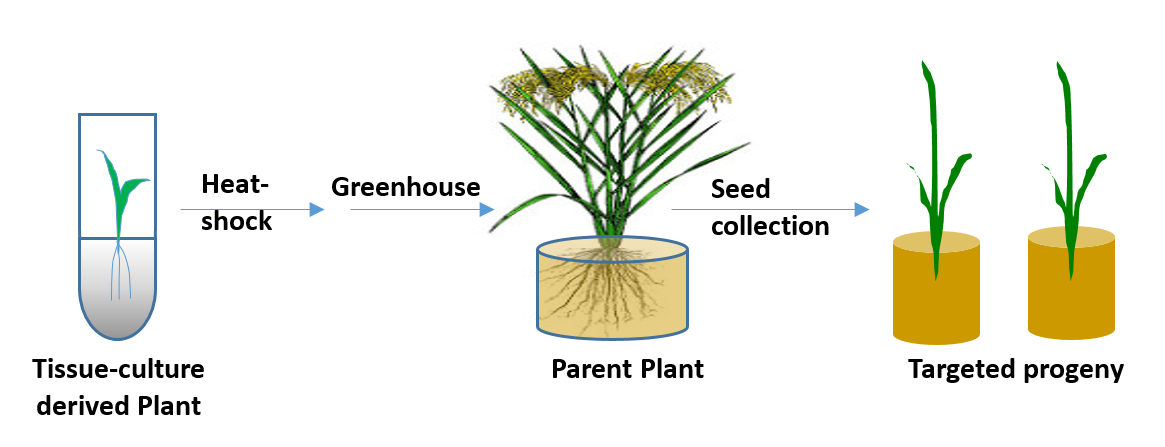
Inducible CRISPR-Cas9 Improves the Precision of Genome Editing in Rice
September 18, 2019| |
DNA delivery into tissue cultures is a simple method for expressing CRISPR-Cas9 and creating genome edits in the plants. This approach, however, allows strong doses of CRISPR-Cas9 to persist far beyond the incidence of targeting i.e. until genetic segregation of the Cas9 gene.
Although precision is an inherent quality of CRISPR-Cas9, the strong persistent doses in numerous cells throughout the life span of the plant is concerning. Specifically, overexpression of CRISPR-Cas9 could lead to targeting of numerous other sites in the genome.
University of Arkansas scientists developed an inducible CRISPR-Cas9 system for controlled genome editing, and demonstrated its efficiency and precision in rice. CRISPR-Cas9 could be induced by one-step heat-shock treatment leading to high incidence of targeted mutations in the rice plants that were inherited by the progeny (Fig. 1). In summary, this inducible CRISPR-Cas9 is a controlled, reasonably efficient platform for genome editing, and therefore, a promising tool for improving the precision of genome editing methods.
Read the research article in Plant Direct for more information.
| |
You might also like:
- Pocket K No. 54: Plant Breeding Innovation: CRISPR-Cas9
- Genome Editing in Agriculture: Methods, Applications, and Governance
- CRISPR-Cas9 Used to Develop Lignin-enriched Rice
Biotech Updates is a weekly newsletter of ISAAA, a not-for-profit organization. It is distributed for free to over 22,000 subscribers worldwide to inform them about the key developments in biosciences, especially in biotechnology. Your support will help us in our mission to feed the world with knowledge. You can help by donating as little as $10.
-
See more articles:
-
News from Around the World
- Millions of Farmers Worry-free Due to Biotech Benefits
- Survey Reflects US Public Views, Knowledge on Gene Drives
- Researchers Make Breakthrough in Understanding Citrus Greening Bacteria
- South Korea Develops GM Crops for Future Use
- PH Legislators and Judicial Members Engage in Agri-biotech Discussions
- Join the Science and She campaign
- Advanced Breeding Makes Disease Resistant Beans Possible
- Tomato Jumping Genes Could Help Speed-breed Drought Resistant Crops
-
Research Highlights
- Transformation of OsNAC10 Gene for Drought Tolerance in Rice
- Scientists Update Chinese Soybean Genome to Golden Reference
-
Plant
- Language, Key in Communicating about Genome Editing
- Inducible CRISPR-Cas9 Improves the Precision of Genome Editing in Rice
-
Read the latest: - Biotech Updates (December 17, 2025)
- Gene Editing Supplement (December 17, 2025)
- Gene Drive Supplement (February 22, 2023)
-
Subscribe to BU: - Share
- Tweet

